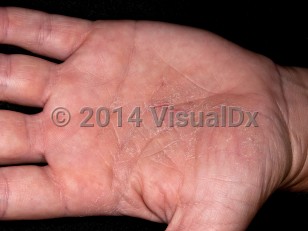Acute hand dermatitis presents with pruritus, erythema, and vesicles that can erupt, weep, and crust. If left untreated, affected areas may develop scales that can progress into lichenification and fissuring. Chronic hand dermatitis is defined as persistent hand dermatitis lasting longer than 3 months or recurring 2 or more times per year. Symptoms of chronic hand dermatitis often include redness, scaling, and itching that drastically impact patients' quality of life.
Hand dermatitis can be subdivided according to the underlying etiology.
Common Etiologies:
Atopic hand dermatitis – Family or personal history of atopy increases risk of atopic, allergic contact, and irritant contact dermatitis. Lesion sites are prone to secondary impetiginization with Staphylococcus aureus.
Allergic contact hand dermatitis – A type IV delayed hypersensitivity reaction to an allergen developing several days after initial exposure. Characterized by itching, burning, and pain. This often follows irritant contact dermatitis and can be found anywhere on the body.
Examples of common contact allergen exposures include:
Rubber allergens
- Exposure – latex, thiuram, carba mix
- Association – gloves, healthcare workers
- Exposure – fragrance mix, balsam of Peru
- Association – skin care products, hair products
- Exposure – methylchloroisothiazolinone, methylisothiazolinone, quaternium-15, formaldehyde
- Association – skin care products, lubricants, household cleaning products
- Exposure – nickel, potassium dichromate, gold, cobalt chloride, chromium
- Association – jewelry, keys, coins, buttons, tools
- Exposure – neomycin sulfate, bacitracin
- Association – topical antibiotics
- Exposure – poison oak / ivy
- Association – hiking, outdoor exposure
Hyperkeratotic / psoriasiform dermatitis – Etiology is idiopathic but thought to be from the repetitive mechanical forces of friction and pressure. It develops slowly over time and is more common among men aged 40-60 years and persons with an extended history of manual labor. This form of dermatitis tends to be chronic and difficult to treat effectively.
Nummular dermatitis – The plaques are mildly pruritic, asymmetric, and likely appear elsewhere on the body. Ask the patient about a history of eczema.
Pompholyx / dyshidrotic eczema / vesicular hand dermatitis – Idiopathic, episodic recurrences of vesicles and bullae on the palms, fingers, and toes. Between episodes, the skin appears normal, but during flares it will often become intensely pruritic.
More than 70% of all hand dermatitis cases are due to some combination of atopic dermatitis, allergic contact dermatitis, and irritant contact dermatitis. The condition is more prevalent among females and those in occupations that involve contact with mechanical and chemical irritants, as well as a repetitive wet-dry cycle ("wet work") of the hands associated with frequent handwashing. These occupations include agricultural workers, mechanics / automotive workers, healthcare professionals, food industry workers, janitors / cleaners, construction workers, painters, electricians, beauticians / hairdressers, and caretakers of newborns or older adults. See also dermatitis of nail folds.
Nearly all forms of hand dermatitis affect the epithelial barrier, which can occur due to both genetic and environmental factors. Disruption of the superficial stratum corneum layer and deficiencies in the protective lipid bilayer result in transepidermal water loss and xerosis. This loss of barrier function lowers the threshold for inflammation and results in skin that is more sensitive to environmental triggers such as irritants and allergens.



 Patient Information for
Patient Information for 
